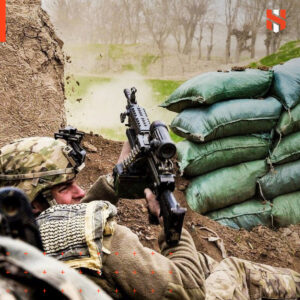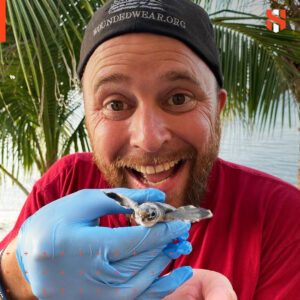FACING STIGMA” WITH KEVIN Z.
October 6, 2022

“I didn’t do that well in high school but I still wanted to go to college. The military was originally a means for me to go to school and mature a bit in the process. I signed up for the Air Force in 1997 and worked as an aircraft calibration technician in North Carolina for a few years and then Okinawa, Japan for two years. I was about to get out of the military in September 2001 and move to Hawaii; 9/11 changed all of that. I asked the Air Force to change my paperwork and allow me to stay in. I was eventually force retrained into combat camera. I didn’t fight it at all because I wanted to stay in and was willing to take any job they offered. I went through training as fast as possible and was sent to Afghanistan nine months later. I was attached to an Army unit and worked with a psychological operations team. That first deployment wasn’t that kinetic and was pretty uneventful in comparison to my other deployments. My second deployment in 2010 was really interesting in the sense that I was yet again attached to another Army unit who then attached me to an Italian combat camera team in western Herat, Afghanistan. I was under the direct command of an Italian Major and Warrant Officer, which made for an interesting dynamic because I didn’t speak any Italian. We wound up linking up with some cavalry scouts at this remote post in the middle of nowhere. We ended up rolling up and being attached to that cavalry unit and working in this valley that was used to smuggle drugs to Iran and fund the Taliban’s war on terror. While the western part of Afghanistan was supposedly more peaceful, it was anything but that because that valley happened to be their main drug export route. It was really this violent place but an extremely important location because if we cut off their money supply, it would a big win for us. It was daily fighting and on foot because of the terrain we were in.
I think that because of the nature of what we were doing and being JSOC (Joint Special Operations Command) missions, it was definitely underreported on what was going on there. We weren’t really talking about what we were doing but it was definitely a kinetic part of the country. A lot of people talk about the western part of Afghanistan being this sleepy part of the country but that’s not how I remembered it. In fact, April 2011 there were twelve of us that got pinned down in this field by over 100+ Taliban members. We had this set of ruins that we tried to fortify because it was our best fighting position as far as cover.  They were dialed into our position and the room that I was fighting in got hit by quite a few different RPGs. I was going back and forth between camera and rifle when I saw an RPG coming directly at me. Your brain processes it and I remember seeing it coming and I actually have video of it from my helmet cam as it whizzes past my shoulder and lands on the ground five feet behind me. It exploded and threw me off my feet head first into a wall where I was briefly knocked unconscious. All five of us in the room were injured by shrapnel and seven out of eleven of us were wounded. After that, I deployed a third time and it was similar in the sense that I fell under the Army command and worked alongside the Italians again in Afghanistan. I really fell off the map on that deployment because we had no power grid so I ended up staying two months longer than I was supposed to. Upon my return I was put up against a medical evaluation board and they determined I wasn’t fit for service. I petitioned and begged to stay in so they allowed me to stay on active, limited duty and I was no longer allowed to deploy. I ended up getting a job as a photographer for Air Force One, but I was also the spokesman for the Blue and White Fleet because my job was rolled up under the public affairs sector. It was a great mission while I was there but after a suicide attempt, I was unfortunately med boarded again and medically retired in January 2018.
They were dialed into our position and the room that I was fighting in got hit by quite a few different RPGs. I was going back and forth between camera and rifle when I saw an RPG coming directly at me. Your brain processes it and I remember seeing it coming and I actually have video of it from my helmet cam as it whizzes past my shoulder and lands on the ground five feet behind me. It exploded and threw me off my feet head first into a wall where I was briefly knocked unconscious. All five of us in the room were injured by shrapnel and seven out of eleven of us were wounded. After that, I deployed a third time and it was similar in the sense that I fell under the Army command and worked alongside the Italians again in Afghanistan. I really fell off the map on that deployment because we had no power grid so I ended up staying two months longer than I was supposed to. Upon my return I was put up against a medical evaluation board and they determined I wasn’t fit for service. I petitioned and begged to stay in so they allowed me to stay on active, limited duty and I was no longer allowed to deploy. I ended up getting a job as a photographer for Air Force One, but I was also the spokesman for the Blue and White Fleet because my job was rolled up under the public affairs sector. It was a great mission while I was there but after a suicide attempt, I was unfortunately med boarded again and medically retired in January 2018.
I didn’t mind killing the Taliban because I thought they were monsters and terribly oppressive people, but the irony is I was becoming that myself at home. I could see it in my kids’ eyes and how they were scared of me because I was emotionally and verbally abusive. I was so horrible at home and with my family that suicide seemed like the only option. I ended up coming to this realization that it wouldn’t end their pain. If anything it was going to fracture that pain and amplify it and put it on all the people I loved. I called 911 and went to Walter Reed and The Intrepid Center of Excellence for my TBI. I went through all that and some inpatient and outpatient stuff as well. I started going to the Vet Center in Alexandria and getting treatment and cutting down on my meds when I heard about Headstrong from my friend, Pasha Palanker. He really urged me to get some continuance of care with my mental health so I reached out last year and started getting treatment. I didn’t think I needed it but after doing my sessions, I realized I needed it desperately. I haven’t been suicidal since then and Headstrong has definitely helped me by leaps and bounds. Looking back on my Air Force roots, I was in a pretty safe and comfortable career field and I was operating in this selfish “what can the military do for me“ attitude. That grew into something more and the path my career took allowed me to meet some of the most amazing human beings on this planet.  Through my mental health struggles, it’s those people I was honored enough to come across that I think of and how could I betray them and depart selfishly. I think it’s those people that in some way keep me alive to this day. I’m glad I had the honor of being able to capture and tell the stories of the heroes I worked with. Those men and women were from all different backgrounds, but they were real life heroes and I don’t use that term loosely. They made daily sacrifices for the good of the country and it was a huge honor to be in their space and a part of their story.”
Through my mental health struggles, it’s those people I was honored enough to come across that I think of and how could I betray them and depart selfishly. I think it’s those people that in some way keep me alive to this day. I’m glad I had the honor of being able to capture and tell the stories of the heroes I worked with. Those men and women were from all different backgrounds, but they were real life heroes and I don’t use that term loosely. They made daily sacrifices for the good of the country and it was a huge honor to be in their space and a part of their story.”










